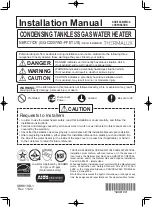
34
4.
Turn vertical gas pipe from manifold slightly and
unscrew gas valve.
5.
Reverse above procedure to reinstall.
Main Burner And Orifice Removal
1. Remove burner tray, following above procedure.
2.
Remove screws and burner hold-down bracket.
NOTE:
If the heat exchanger is sooted badly, the burner
hold-down bracket and spacer can become distorted
from direct-flame impingement and this usually
necessitates replacement of these parts.
3. Lift burners from slotted spacers and slide from
orifices. Clean with a wire brush.
4.
Orifices usually do not need to be replaced. To clean,
run either copper wire or wood toothpick through
orifice.
Do not
enlarge hole. To remove orifice, use a
socket wrench and remove from manifold.
DO NOT
overtighten when reinstalling.
Pilot Removal And Cleaning
1. Disconnect pilot tubing and wires from gas valve.
2.
Remove pilot assembly from burner tray.
3. Remove pilot from bracket.
4.
Remove pilot orifice and air opening, and clean with
wire or small brush.
A
A
CAUTION!
Do not enlarge hole in pilot orifice.
5.
Reverse above procedure to reinstall.
PILOT
ORIFICE
AIR
OPENING
Figure 61. Millivolt Pilot
Figure 62. Digital Pilot
Heat Exchanger Removal
1. Shut water, gas and electricity off, close valves and
relieve pressure, then remove relief valve. Remove
side access panels.
2.
Remove top jacket holding screws.
3. Remove rear top panel.
4.
Remove screws mounting the rain shield to the rear
panel. Also remove the screws that mount the rain
shield to the sway brace. Remove rain shield.
5.
Remove the four (4) screws holding down the flue
collector. Remove the flue collector.
6.
Disconnect flange nuts on Inlet/Outlet header,
remove ProTek Shield Assy bonding wire from heat
exchanger stud, loosen union at gas pipe and slide
heater away from piping.
7. Lift heat exchanger straight up using caution not to
damage refractory.
8.
Reverse above procedure to reinstall. Make sure the
insulation strips are properly replaced on top of the
refractory retainer.
Tube Cleaning Procedure
Establish a regular inspection schedule, the frequency
depending on the local water conditions and the severity
of service. Do not let the tubes clog up solidly. Clean out
deposits over 1/16" (1.6 mm) in thickness.
The heater may be cleaned from the return header
side, without breaking pipe connections. It is preferable,
however, to remove both headers for better visibility
through the tubes and to be sure the ground-up lime dust
does not get into the system. Note that you do not remove
the top panel or the heater exchanger, generally.
After reaming, mount the wire brush in place of the auger
and clean out debris remaining in the tubes.
Another method is to remove the heat exchanger, ream
tubes and immerse heat exchanger in non-inhibited de-
scale solvent for severe scale build-up.
Extension
Pieces (2)
Auger
with Carbide Tip
Wire Brush
Figure 63. Tube Cleaning Kit
Desooting Procedure
A
A
WARNING:
Soot Is Combustible. Exercise Extreme
Care.
Soot will clog areas between fins and cause eventual
tube failure. Any sign of soot at the base of the burners or
around the outer jacket indicates a need for cleaning.
6000.59AG_Atmospheric.indd 34
11/22/2019 9:50:28 AM
Содержание 206A
Страница 24: ...24 6 WIRING DIAGRAM MILLIVOLT 6000 59AG_Atmospheric indd 24 11 22 2019 9 50 22 AM...
Страница 25: ...25 7 WIRING DIAGRAM DIGITAL 6000 59AG_Atmospheric indd 25 11 22 2019 9 50 23 AM...
Страница 51: ...51 NOTE 6000 59AG_Atmospheric indd 51 11 22 2019 9 50 40 AM...
Страница 52: ...6000 59AG_Atmospheric indd 52 11 22 2019 9 50 40 AM...
















































